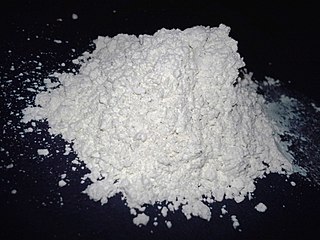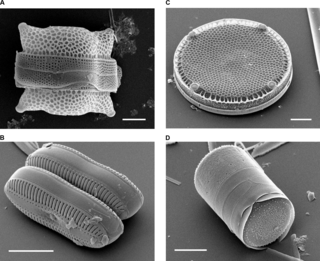
Diatomic molecules are molecules composed of only two atoms, of the same or different chemical elements. If a diatomic molecule consists of two atoms of the same element, such as hydrogen or oxygen, then it is said to be homonuclear. Otherwise, if a diatomic molecule consists of two different atoms, such as carbon monoxide or nitric oxide, the molecule is said to be heteronuclear. The bond in a homonuclear diatomic molecule is non-polar.

A diatom is any member of a large group comprising several genera of algae, specifically microalgae, found in the oceans, waterways and soils of the world. Living diatoms make up a significant portion of the Earth's biomass: they generate about 20 to 50 percent of the oxygen produced on the planet each year, take in over 6.7 billion tonnes of silicon each year from the waters in which they live, and constitute nearly half of the organic material found in the oceans. The shells of dead diatoms can reach as much as a half-mile deep on the ocean floor, and the entire Amazon basin is fertilized annually by 27 million tons of diatom shell dust transported by transatlantic winds from the African Sahara, much of it from the Bodélé Depression, which was once made up of a system of fresh-water lakes.
Fucoxanthin is a xanthophyll, with formula C42H58O6. It is found as an accessory pigment in the chloroplasts of brown algae and most other heterokonts, giving them a brown or olive-green color. Fucoxanthin absorbs light primarily in the blue-green to yellow-green part of the visible spectrum, peaking at around 510-525 nm by various estimates and absorbing significantly in the range of 450 to 540 nm.

Diatomaceous earth, diatomite, celite or kieselgur/kieselguhr is a naturally occurring, soft, siliceous sedimentary rock that can be crumbled into a fine white to off-white powder. It has a particle size ranging from more than 3 mm to less than 1 μm, but typically 10 to 200 μm. Depending on the granularity, this powder can have an abrasive feel, similar to pumice powder, and has a low density as a result of its high porosity. The typical chemical composition of oven-dried diatomaceous earth is 80–90% silica, with 2–4% alumina, and 0.5–2% iron oxide.
In chemistry, homonuclear molecules, or homonuclear species, are molecules composed of only one element. Homonuclear molecules may consist of various numbers of atoms. The size of the molecule an element can form depends on the element's properties, and some elements form molecules of more than one size. The most familiar homonuclear molecules are diatomic molecule, which consist of two atoms, although not all diatomic molecules are homonuclear. Homonuclear diatomic molecules include hydrogen, oxygen, nitrogen and all of the halogens. Ozone is a common triatomic homonuclear molecule. Homonuclear tetratomic molecules include arsenic and phosphorus.

Paleolimnology is a scientific sub-discipline closely related to both limnology and paleoecology. Paleolimnological studies focus on reconstructing the past environments of inland waters using the geologic record, especially with regard to events such as climatic change, eutrophication, acidification, and internal ontogenic processes.

Navicula is a genus of boat-shaped diatom algae, comprising over 1,200 species. Navicula is Latin for "small ship", and also a term in English for a boat-shaped incense-holder.

Diatomic carbon (systematically named dicarbon and 1λ2,2λ2-ethene), is a green, gaseous inorganic chemical with the chemical formula C=C (also written [C2] or C2). It is kinetically unstable at ambient temperature and pressure, being removed through autopolymerisation. It occurs in carbon vapor, for example in electric arcs; in comets, stellar atmospheres, and the interstellar medium; and in blue hydrocarbon flames. Diatomic carbon is the second simplest of the allotropes of carbon (after atomic carbon), and is an intermediate participator in the genesis of fullerenes.
In botany, a zoid or zoïd is a reproductive cell that possesses one or more flagella, and is capable of independent movement. Zoid can refer to either an asexually reproductive spore or a sexually reproductive gamete. In sexually reproductive gametes, zoids can be either male or female depending on the species. For example, some brown alga (Phaeophyceae) reproduce by producing multi-flagellated male and female gametes that recombine to form the diploid sporangia. Zoids are primarily found in some protists, diatoms, green alga, brown alga, non-vascular plants, and a few vascular plants. The most common classification group that produces zoids is the heterokonts or stramenopiles. These include green alga, brown alga, oomycetes, and some protists. The term is generally not used to describe motile, flagellated sperm found in animals. Zoid is also commonly confused for zooid which is a single organism that is part of a colonial animal.

The order Pennales is a traditional subdivision of the heterokont algae known as diatoms. The order is named for the shape of the cell walls of pennate diatoms, which are elongated in valve view. The valves may be linear or oval in shape, and usually bear bilaterally symmetrical ornamental patterns. These patterns are composed of a series of transverse lines that can appear as rows of dots when viewed with an optical microscope. Some pennate diatoms also exhibit a fissure along their longitudinal axis. This is known as a raphe, and is involved in gliding movements made by diatom cells; motile diatoms always possess a raphe.

The Coscinodiscophyceae are a class(s) of diatoms. They are similar to the Centrales, a traditional, paraphyletic subdivision of the heterokont algae known as diatoms. The order is named for the shape of the cell walls of centric diatoms, which are circular or ellipsoid in valve view. The valves often bear radially symmetrical ornamental patterns that can appear as dots when viewed with an optical microscope. Some also bear spines on their valves, which may either increase cell surface area and reduce sinking, or act as a deterrent to zooplankton grazers. Unlike pennate diatoms, centric diatoms never have a raphe.

A frustule is the hard and porous cell wall or external layer of diatoms. The frustule is composed almost purely of silica, made from silicic acid, and is coated with a layer of organic substance, which was referred to in the early literature on diatoms as pectin, a fiber most commonly found in cell walls of plants. This layer is actually composed of several types of polysaccharides.

Bolidophyceae is a class of photosynthetic heterokont picophytoplankton, and consist of less than 20 known species. They are distinguished by the angle of flagellar insertion and swimming patterns as well as recent molecular analyses. Bolidophyceae is the sister taxon to the diatoms (Bacillariophyceae). They lack the characteristic theca of the diatoms, and have been proposed as an intermediate group between the diatoms and all other heterokonts.

Siliceous ooze is a type of biogenic pelagic sediment located on the deep ocean floor. Siliceous oozes are the least common of the deep sea sediments, and make up approximately 15% of the ocean floor. Oozes are defined as sediments which contain at least 30% skeletal remains of pelagic microorganisms. Siliceous oozes are largely composed of the silica based skeletons of microscopic marine organisms such as diatoms and radiolarians. Other components of siliceous oozes near continental margins may include terrestrially derived silica particles and sponge spicules. Siliceous oozes are composed of skeletons made from opal silica SiO2·nH2O, as opposed to calcareous oozes, which are made from skeletons of calcium carbonate (CaCO3·nH2O) organisms (i.e. coccolithophores). Silica (Si) is a bioessential element and is efficiently recycled in the marine environment through the silica cycle. Distance from land masses, water depth and ocean fertility are all factors that affect the opal silica content in seawater and the presence of siliceous oozes.

Ochrophytes, also known as heterokontophytes or stramenochromes, are a group of algae. They are the photosynthetic stramenopiles, a group of eukaryotes, organisms with a cell nucleus, characterized by the presence of two unequal flagella, one of which has tripartite hairs called mastigonemes. In particular, they are characterized by photosynthetic organelles or plastids enclosed by four membranes, with membrane-bound compartments called thylakoids organized in piles of three, chlorophyll a and c as their photosynthetic pigments, and additional pigments such as β-carotene and xanthophylls. Ochrophytes are one of the most diverse lineages of eukaryotes, containing ecologically important algae such as brown algae and diatoms. They are classified either as phylum Ochrophyta or Heterokontophyta, or as subphylum Ochrophytina within phylum Gyrista. Their plastids are of red algal origin.

Forensic limnology is a sub-field of freshwater ecology, which focuses especially on the presence of diatoms in crime scene samples and victims. Different methods are used to collect this data but all identify the ratios of different diatom colonies present in samples and match those samples with locations at the crime scene.

Surirellaceae is a family of diatoms in the order Surirellales.

Thalassiosira is a genus of centric diatoms, comprising over 100 marine and freshwater species. It is a diverse group of photosynthetic eukaryotes that make up a vital part of marine and freshwater ecosystems, in which they are key primary producers and essential for carbon cycling

Bacilladnaviridae is a family of single-stranded DNA viruses that primarily infect diatoms.

Diatoms belong to a large group called the heterokonts, which include both autotrophs such as golden algae and kelp; and heterotrophs such as water moulds. The classification of heterokonts is still unsettled: they may be designated a division, phylum, kingdom, or something intermediate to those. Consequently, diatoms are ranked anywhere from a class, usually called Diatomophyceae or Bacillariophyceae, to a division (=phylum), usually called Bacillariophyta, with corresponding changes in the ranks of their subgroups.
















